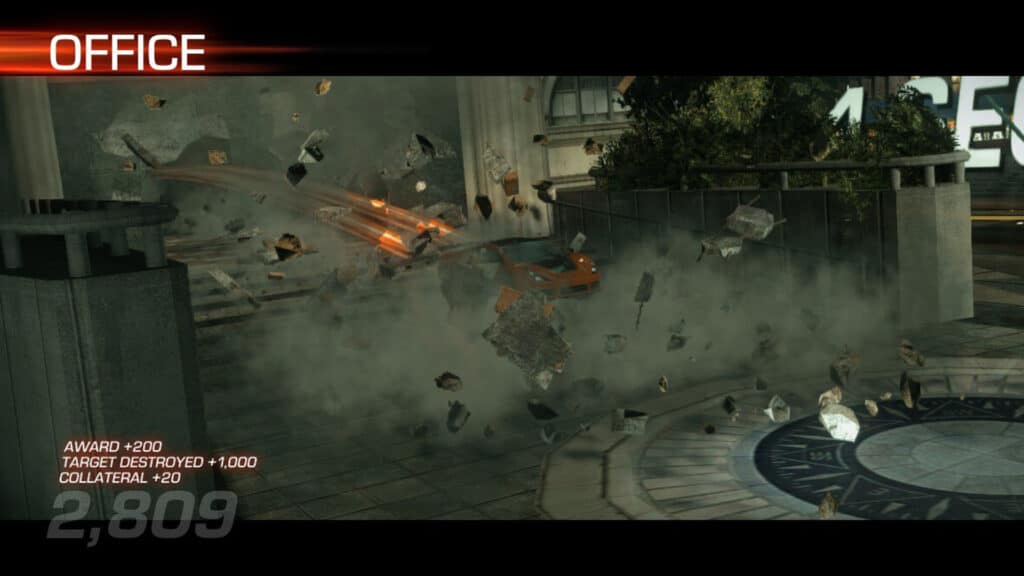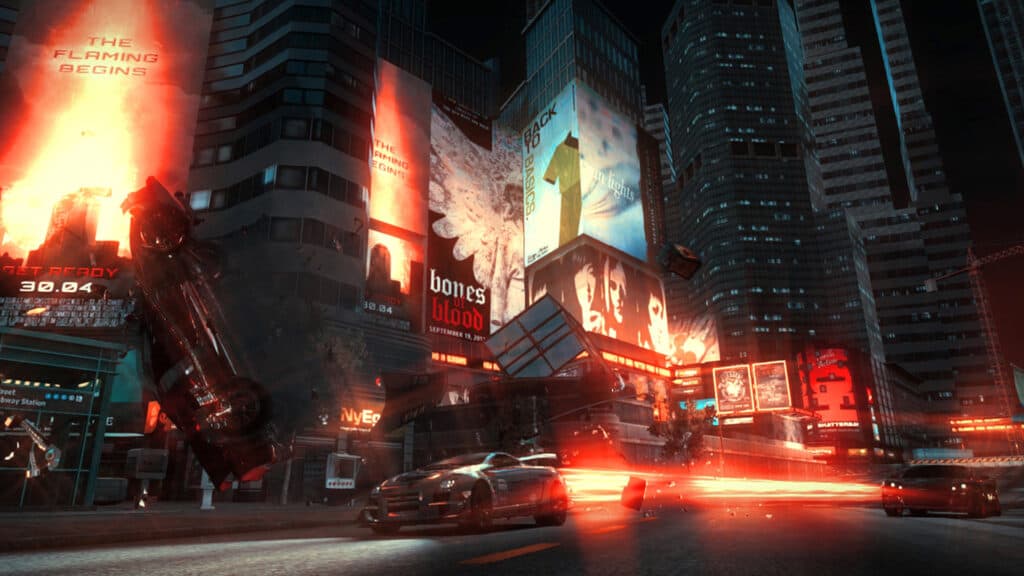When you look through Ridge Racer‘s gameography, tears of frustration burning your cheeks, one title stands out as the last nail in its coffin: Ridge Racer Unbounded.
Nobody knows why the ‘ed’ is on the end there, but hey-ho. On a more fundamental level, it remains the Ridge Racer that is absolutely nothing like Ridge Racer.
Having reviewed poorly at the time, it’s effectively vanished from the collective consciousness. After more than a decade, it’s still available on Steam and runs at a solid 60fps on Steam Deck. It’s also only £7.99/$9.99, and with modern, bombastic, arcade-styled racers few and far between, perhaps it’s got something to offer after all?

Burnout changed the game
Playing Ridge Racer Unbounded in 2023 is a strange experience. Strange because it hails from an era where car destruction expectations had been ramped up considerably by Burnout Paradise. And while Unbounded doesn’t quite equal Paradise’s still-phenomenal damage modelling, it’s a decent approximation.
Cars dent, disintegrate and catch fire in cool slow-motion, and the camera lingers on takedown cutaways (or ‘frags’ as they’re known here, which surely just steals from Quake rather than Burnout) for far longer than games dare today, allowing cars to reach the walls, where you’re treated to a display of destruction physics.
After the PlayStation 2 brought solid geometry and draw distance to the genre, Unbounded hails from the PS3/360 era of gaming where the possibilities were more than skin deep. And so, you get a wealth of physics objects to careen through, and impressively breakable walls and barriers.

Destruction derby
It makes a lot more sense when you note the game was developed by Bugbear, who had already made the FlatOut games by that point, and would go on to make Wreckfest, a particular Traxion.GG favourite today.
But that time also saw explorative gameplay features making the most of this new destructive potential. Sega’s early Xbox 360 title Full Auto features similar environmental destruction (only with a projectile-based weapons system that would have definitely been one step too far from the Ridge Racer template), and the obviously similar Split/Second (Velocity) had been released a couple of years beforehand, which introduced set-piece elements to the racing action.

While Unbounded uses environmental set-pieces to trigger destruction-based takedowns, it doesn’t have the scale or variety of Split/Second, which is a shame because the destruction itself was ahead of its time.
But we’ve come all this way without talking about why it’s a Ridge Racer game, and honestly, it’s difficult to point to any one area where it’s recognisable as such.
A woman’s voice announces the arrival of fancy-looking, fictional race cars, which is perhaps the most obvious giveaway, and you can ride with a bumper cam, though to do so would be missing out on the still-lovely reflective bodywork of your car.

Finally, there’s the drift mechanism, which is triggered with its own button, though it feels like an afterthought. It’s perhaps the most disappointing feature, as it doesn’t enable particularly great cornering on tight turns, and can see you stuck in a fishtail that puts you into a wall.
The game instead chooses to do its own thing, using slipstreaming and drifting to fill a boost bar, which not only gives you an explosion of speed, but allows you to smash through flagged sections of scenery, either fragging rivals with the shockwave, or simply taking a shortcut through the local police station.
It also allows you to smash into rivals, flipping them out spectacularly.

Ice cream pizza
It sounds like fun but, disappointingly, the ingredients don’t produce quite as many endorphins as they should. The takedown mechanism relies too heavily on having that boost gauge full, and events that are frag-based are too simplistic, requiring you only to touch rival cars while boosting to trigger the frag, meaning the most minor, incidental touches trigger massive catastrophes of twisted metal.
Such constant extremes dilute the experience, rather than delivering super-rewarding moments of automotive vandalism. And most damningly, Burnout already did it better, albeit without allowing cars to smash through concrete pillars in the process.
Unbounded features an embryonic ‘revenge’ system too but, again, it’s too incidental and the payoff isn’t big enough for successfully taking down your foe.

Of an era
All that said, in today’s climate it’s still got something modern games haven’t. The arcade stylings make for a pick-up-and-play experience focused on action rather than finesse, and the Steam version runs so smoothly now, it’s hard to imagine it not doing reasonably well on release.
But that’s with modern PC tech and a totally different climate. Rewind to 2012 and the game’s console versions were capped at 30fps, with the PS3 version also exhibiting screen tearing, while at least delivering smooth motion, which wasn’t all that common for cross-platform games at the time.
The art style was dark even for those angsty times, and the visuals were a blurry, shadow-soaked dirge of black and orange. It didn’t look moody; it just looked dark.

At times, innovative
There are some elements that should have stuck around in the genre for longer, however. The way game information is displayed in the 3D environment itself is really neat, updating you on lap count and race position deltas with billboard-sized text graphics that tower around you as you race. That’s cool.
It also requires skill to progress, with rubber-banding only evident in the Frag Attack events, where the game tries to keep cars around you to give you a fighting chance of hitting the three-star quota even if you spin out. It’s decently balanced as a result, challenging without being frustrating.
There’s even a track editor. Completing career mode events unlocks blocks from the city districts that are used to build your own raceway.

You can then populate it with sand pits and ramps, as well as destructible elements, with the results looking every bit as convincing as the main game. It’s impressively versatile, but lacks relevance now the servers are switched off. Meh.
Mistaken identity
Clearly, the game should have been called anything but ‘Ridge Racer’.
It’s rather lovely that the name was given to a studio that had its own idea for the game and was allowed to take the risk. But sadly, said risk really didn’t pay off, and the series was left to rot. This was the last all-new Ridge Racer ever released on PC and console.
To blame that demise on this one game would be unfair, as the series had already split and stagnated by 2012, with the old, PS1-style checkpoint-based racing transitioning to drift-centric, charge-based racing that didn’t even require your car to be facing forward so long as you were in a drift state.

The series needed an injection of something. But with hindsight, Unbounded was an injection of beautiful madness that was simply never going to work. The Joker to Namco’s Batman, if you like.
Too removed for Ridge Racer purists, too moody for fans of blue sky gaming, too ambitious to be convincingly delivered on the console hardware of the time and simply not as good as its obvious rival, Burnout, Ridge Racer Unbounded was destined to fail.
Still, with contemporary technology, at least one of those elements is fixed, and while it still isn’t as good as Burnout, anything in the same ballpark has got to be worth a look today.






Chat with the Community
Sign Up To CommentIt's completely Free